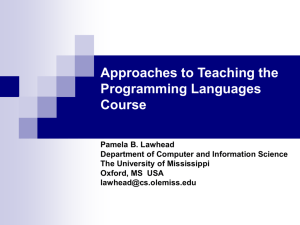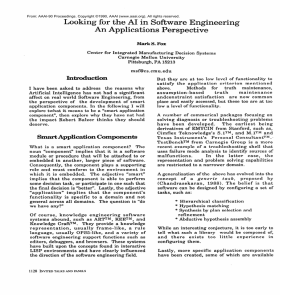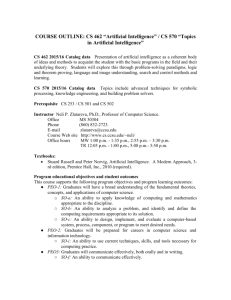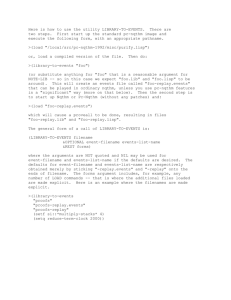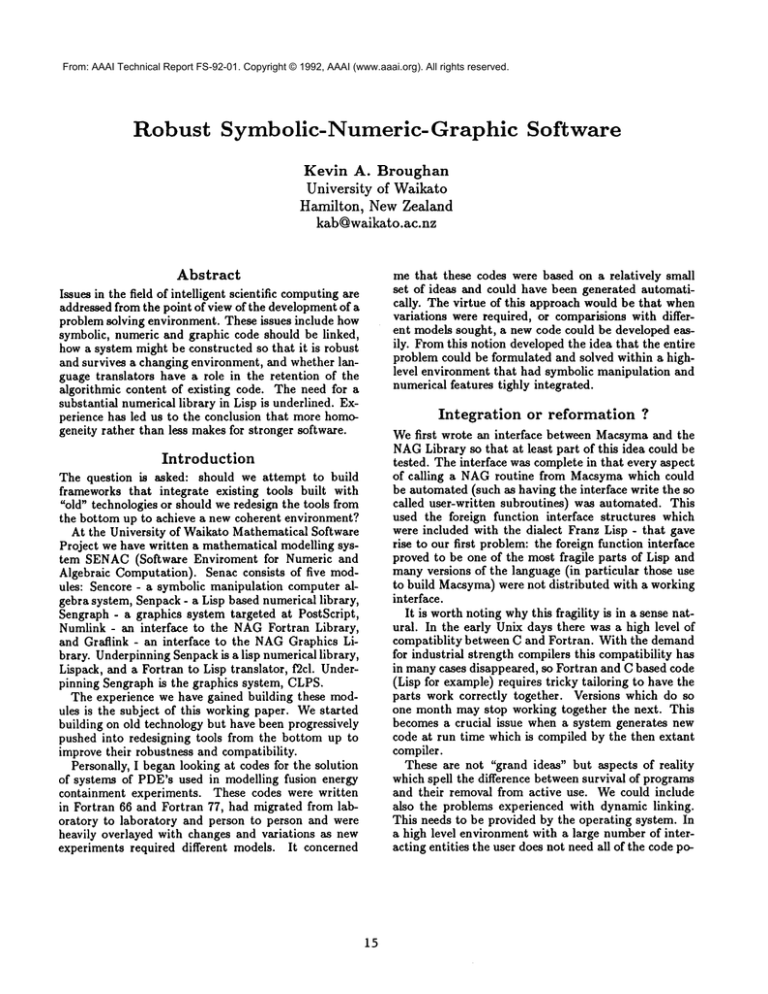
From: AAAI Technical Report FS-92-01. Copyright © 1992, AAAI (www.aaai.org). All rights reserved.
Robust
Symbolic-Numeric-Graphic
Software
Kevin
A. Broughan
University
of Waikato
Hamilton,
New Zealand
kab@waikato.ac.nz
Abstract
Issues in the field of intelligent scientific computingare
addressed from the point of view of the developmentof a
problem solving environment. These issues include how
symbolic, numeric and graphic code should be linked,
how a system might be constructed so that it is robust
and survives a changing environment, and whether language translators have a role in the retention of the
algorithmic content of existing code. The need for a
substantial numerical library in Lisp is underlined. Experience has led us to the conclusion that more homogeneity rather than less makesfor stronger software.
Introduction
The question is asked: should we attempt to build
frameworks that integrate existing tools built with
"old" technologies or should we redesign the tools from
the bottom up to achieve a new coherent environment?
At the University of Waikato Mathematical Software
Project we have written a mathematical modelling system SENAC(Software Enviroment for Numeric and
Algebraic Computation). Senac consists of five modules: Sencore - a symbolic manipulation computer algebra system, Senpack - a Lisp based numerical library,
Sengraph - a graphics system targeted at PostScript,
Numlink - an interface to the NAGFortran Library,
and Graltink - an interface to the NAGGraphics Library. UnderpinningSenpackis a lisp numerical library,
Lispack, and a Fortran to Lisp translator, f2cl. Underpinning Sengraph is the graphics system, CLPS.
The experience we have gained building these modules is the subject of this working paper. Westarted
building on old technology but have been progressively
pushed into redesigning tools from the bottom up to
improve their robustness and compatibility.
Personally, I began looking at codes for the solution
of systems of PDE’s used in modelling fusion energy
containment experiments. These codes were written
in Fortran 66 and Fortran 77, had migrated from laboratory to laboratory and person to person and were
heavily overlayed with changes and variations as new
experiments required different models. It concerned
15
me that these codes were based on a relatively small
set of ideas and could have been generated automatically. The virtue of this approach would be that when
variations were required, or comparisions with different models sought, a new code could be developed easily. From this notion developed the idea that the entire
problem could be formulated and solved within a highlevel environment that had symbolic manipulation and
numerical features tighly integrated.
Integration
or reformation
?
Wefirst wrote an interface between Macsymaand the
NAGLibrary so that at least part of this idea could be
tested. The interface was complete in that every aspect
of calling a NAGroutine from Macsyma which could
be automated (such as having the interface write the so
called user-written subroutines) was automated. This
used the foreign function interface structures which
were included with the dialect Franz Lisp - that gave
rise to our first problem: the foreign function interface
proved to be one of the most fragile parts of Lisp and
manyversions of the language (in particular those use
to build Macsyma)were not distributed with a working
interface.
It is worth noting whythis fragility is in a sense natural. In the early Unix days there was a high level of
compatiblity between C and Fortran. With the demand
for industrial strength compilers this compatibility has
in manycases disappeared, so Fortran and C based code
(Lisp for example) requires tricky tailoring to have the
parts work correctly together. Versions which do so
one month may stop working together the next. This
becomes a crucial issue when a system generates new
code at run time which is compiled by the then extant
compiler.
These are not "grand ideas" but aspects of reality
which spell the difference between survival of programs
and their removal from active use. Wecould include
also the problems experienced with dynamic linking.
This needs to be provided by the operating system. In
a high level environment with a large number of interacting entities the user does not need all of the code po-
From: AAAI Technical Report FS-92-01. Copyright © 1992, AAAI (www.aaai.org). All rights reserved.
tentially available to solve one problem, so some form
or other of dynamic linking is essential. Major vendors have released linker/loaders on high performance
workstations without this feature. Providing automatic
loading of required code within a Lisp environment is
not difficult and provides immunityfrom operating system deficiencies.
The need for different components which are very
tightly linked has been evident. Integration, optimization and differential equation routines, for example, require function evaluations. These function evaluations
can be very complex and require calls to numerical style
code. It is only recently that foreign functions interfaces have supported calbbacks from Fortran or C to
Lisp. Our experience with these has again been somewhat negative - major vendors still find it difficult to
release and maintain robust callbacks.
Foreign functions
remain foreign
Foreign function interfaces continued to be somewhat
less than completely satisfactory, even after the advent
of Common
Lisp in the mid-eighties. They are a nonstandard extension of the standard, lock one into using
interfaced code in its given form, and are quite difficult
to maintain, especially when C and Fortran architectures and library designs diverge. Increasingly we found
we wanted to experiment with lexical scoping, closures,
and parallelisations
in numeric code. Wefound that
Lisp code could be just as fast as C or Fortran. Once
the algorithms are in Lisp then all of this flexibity becomes available. Wesee this as the path forward, although foreign function interfaces will continue to have
a role - especially when foreign code does not require
user supplied functions or call-backs to Lisp.
It is worth stressing this advantage of having numerical algorithms in Lisp. Numerical code can call (compiled or interpreted) symbolic code which can call numerical code in any order or depth and in any manner.
Provided both symbolic and numeric components have
been compiled with the same Lisp compiler they will always work harmoniously together, be they user defined
or system defined functions.
All of this experience has led us to the conclusion
that, wherever possible, code should be written in the
same language. In our case this is CommonLisp.
Where appropriate, foreign code should run as an independent executable program communicating with the
symbolic code over pipes or through temporary files. It
is surprising howwidespread is the use of these primitive and restricted forms of communication.
Fortran to Lisp translation
game
- the new
The body of tried and tested code found in numeric
subroutine libraries is usually given as the reason for
using a foreign function interface rather than rewriting
16
the algorithms. However one should note the current
popularity of the translator f2c. Wewrote a translator f2cl - this really breaks the back of the translating
process. Weused an early form of f2cl to bring up Numerical Recipes in Lisp and then interfaced that code
for Senac. This work is a prelude to the production of
a fuller numeric library in Lisp (Lispack), for which
are guaging interest and seeking support.
I believe this was tried at MITin the seventies. Lisp
compiler technology has improved and the declarations
available in CommonLisp imply that now is a much
better time for this development. Weperformed experiments which showed that the compiled Lisp numeric
code was not at all slow when declarations were used,
but ran at speeds comparable or better than Fortran in
environments with plenty of physical memory.
The translator is at present really a rapid prototyping
tool. There are problably about 15 bugs to be erradicated and a Fortran standard verifier to be obtained
and run as a first pass. The translator handles common
blocks but we don’t attempt to handle those which are
named and then defined in different ways in different
subprograms. We don’t handle equivalences. In our
experience it is only the worst Fortran code which contains these features in any case. Weverified the process
by translating the very popular set of programs Numerical Recipes into Common
Lisp and then interfacing the
Lisp code with Senac. Along the way we used Lisp lea.
tures such as lexical scoping to advantage. Unlike the
f2c translator, where the goal is to have C code which
would run in a Fortran like runtime environment, we
want Lisp code which will run in a Lisp environment.
Thus no attempt is madeto respect the call by reference
mechanism of Fortran.
One way to verify the effectiveness of f’2cl would be
to translate
a system like LAPACK
from Fortran to
Lisp. This is one of the ideas we have for the further
development of Lispack.
The use of AI tools
What AI tools have been found useful in automating
phases of the scientific enquiry process ? Of course this
question leaves open the matter of when something is
an AI tool and when it is not. Weinterpret it to mean
the use of a greater degree of automation than normal
in scientific computation.
In addition to the Fortran to Lisp translator, language translation and program generation have been
used extensively both in the development of the original
code and are provided for the user. Numlink was developed using a Lisp based rapid prototying tool which
produced most of each interface routine from the Fortran subroutine header, including the variable declarations. Sencore contains a language translator from
Senac internal froms to Fortran Forms. Interface programs contain program generators for creating, at run
time, the user written subroutines.
From: AAAI Technical Report FS-92-01. Copyright © 1992, AAAI (www.aaai.org). All rights reserved.
Wechose Lisp for software development because of
the range of features and data types, the history and
current impetus of the language, the evolution of standards, the number of strong vendors and the fact that
the langage itself was vendor independent. The development of Lisp compiler technology has been strong.
Features such as closures, lexical scoping, macros, continuations, the object oriented system, and the condition system become increasingly important and very
difficult for single vendor languages to match. Wenow
have had in-depth experience with Franz Lisp, XLisp,
Scheme, AKCL, VAXLISP and Allegro CL. Serious
users can now write Lisp code, which will run with
systems like Senac, knowing that the code has more
professional support, cannonical language features and
compiler support than any language produced by a single vendor.
A deficiency with current Lisp systems: real life problems are large. Lisp tends to manage its own storage requirements until these are exhausted wherein the
sytem, in general, dies. Building a new and bigger Lisp
is the normal exhortation of user manuals. Keeping the
size not too large is important because incorrectly structured recursive calls frequently are the cause of resource
exhaustion. Automating the growth of the system (i.e
making it dynamic) but catching incorrect recursive
calls would be a valuable improvement. Users should
not be expected to have to rebuild Lisp. Developers of
Lisp based systems should not need to distribute the
facilities for rebuilding Lisp and then rebuilding their
application.
Two questions related to code generation: Howcan
science users become more confortable and more trusting of automatically
generated code? How can increased confidence be facilitated by the design of code
generation sytems ?
Our approach in the past has been to regard the
translation and generation of code as an internal step
so that the user does not need to ever view the system
produced code. Users trust compilers by considering
their results. With f2cl, however, we attempt to make
the Lisp code reflect the logic, variable names and sequencing of the Fortran code. Maybethis will instill
more confidence in potential users.
A framework
for scientific
computing
Can we understand the complexity of scientific software,
design a better framework for scientific programming,
and design software to fit into that framework so that
we can integrate new technologies into scientific environments ?
A key sub-issue here is that an environment needs to
be extensible by a user. Manylayers of user extensibility are possible but one primary need is perceived.
Whena user defines a family of functions these should
be able to be compiled. Insufficient speed remains a
good reason for why scientists with serious problems
refrain from trying higher level techniques.
Real-world
problems
How can symbolic computing be integrated with numeric computation in solving real-world complex problems ? What advances do we know we need in symbolic
algebra systems (e.g. parallel methods)
Muchof the NAGLibrary is targeted at rather small
problems. Take the optimization routines for example.
In the development of Numlink we were somewhat led
astray by this "smallness" approach and established a
matrix data type using Lisp s-expessions as the normal form of input for interfaced routines requiring matrix data. This is inadequate for large problems. Special data types for sparse matrices go somewaytowards
reparing this defficiency but arrays at the Symboliclanguage level are the natural solution.
An illustration of this idea from linear programming
where the number of variables in real-world problems
is often trully large. In an integrated symbolic numeric
environment the user should be able to introduce each
constraint, or indexed family of constraints, using symbolic arrays and symbolic inequalities looking like mathematical expressions. I believe there are PC spreadsheet
type programs which allow this. Wehope to have verified that this approach is possible and useful in the
Senpack setting by the time of the symposium. Based
on our experience with hydro system modelling (see below) the difficulty of inputing complexconstraints into
real world LP type programs is very significant. When
the model has a significant number of integer variables
then researching effective methodsof guiding the search
for a solution is a very good AI problem I feel.
I believe one has still to include Linear Programming
in the "Grand Challenges" bag. Wherever one goes,
problems which are most easily modelled using mixed
integer/real
linear programming appear and are being
used for the solution of serious (economically important) problems. Weare building a model for the nearby
Waikato river system hydro electric stations. There are
8 stations in all and we aim to model demandover a two
day period in one half hour time steps. Solution time
is currently 2 hours - this must be reduced to about 20
minutes on "stock" hardware. There are about 1000
integer variables.
Another aspect of the real-world modelling problem is
the diffence between interactive and batch processing.
We would like to be able to set up the environment
for solving a particlar problem interactively and then
send off the problem to be solved on another, larger,
processor while still continuing to work in the same or
an adjusted environment. The detached process, when
complete, should be able to be inspected interactively.
This is a simplified aspect of a full multiprocessing setup
which would include parallel processing. Weare making first steps and hope that others will go the full
distance in making this distributed processing practi-
From: AAAI Technical Report FS-92-01. Copyright © 1992, AAAI (www.aaai.org). All rights reserved.
cal. Parallel versions of XLisp and Scheme have been
written within the Mathematical Software Project for
a family of Inmos transputers. Load balancing, process
killing, and expression propagation all offer significant
challenges. A more natural environment than the transputers would offer a mixture of coarse and fine grained
parallelism and we believe that such networks are now
becoming available at reasonable cost.
The parallel XLisp was used to implement a parallel probabilistic greatest commondivisor algorithm for
multinomials. The parallel Schemewill be used for the
factorisation of large integers. This latter arrangement
will have different processors computing different but
communicating algorithms.
Symbolic
systems
do help
How can symbolic mathematical systems push an applied computing frontier forward, whether in a direction different from the conventional one or further than
faster numerical computing could ?
Symbolic systems can assist very significantly with
the formulation of problems and the processing of the
output. Within a symbolic manipulation interpreter
the values returned from an evaluation are data types
and not just printed expressions. Thus they are available for futher processing which could be performed by
a program. This is a simple but very significant idea,
considering the time that is spent writing code to format output or read formatted data. As well we have the
symbolic computation of derivatives and many other
well knownways in which symbolic systems can assist.
Experiments with Numlink showed that for some routines (especially those requiring user-written subprograms) the code development time saved using the symbolic language and an interface was more than two orders of magnitude. With more time to spend thinking about a problem, and trying variations, the frontier
must go forward faster.
The area of partial differential equations requires special attention. Subroutine libraries have data structures
which are not sufficiently flexible to modelaspects such
as domains at all well. (Fortran 90 might change this
however). The discretization of the system could well
be perfomed by a symbolic system. Change of variables is already routinely performed. Ellpack (XEllpack,//Ellpack) is an interesting example of high order
input and it does use Macsyma.Dealing with the complexity of the input data for these problems and striking
the balance between very low level facilities (e.g. the
current situation using a subroutine library for the linear algebra and writing the rest of the solution code in C
or Fortran) or very high level specialized environments
(e.g. Ellpack) are key issues. A positive note - the PDE
area will use intensively most of the aspects we are trying to foster: numeric, symbolic, visualisation, applied
AI.
Regarding our own work: Specifying domains is in an
I8
early state of evolution. Wehave a set of algorithms for
computational geometry (convex hulls, triangulations
of non-convex regions with non-convex holes) but this
is clearly an area with a lot of potential: especially in
three or more dimensions. Again we have found Lisp to
be very flexible for algorithm design.
Somelibrary and system programs (optimisation, elliptic PDEsolvers, linear programmingpackages) have
numerous tuning parameters with non-trivial relations
between these. Wehave found that the resolution algorithm (written in Lisp) provides a sensible and easy
implement approach to checking these parameters and
recognising when they are valid. This applies for instance to an experimental interface to Ellpack for Senac
that we have worked on. These parameter sets should
be able to be altered interactively, which is very natural of course in a Lisp like environment: one need
only make the parameters global variables in appropriate packages or use scoping mechanisms.
Conclusion
If we can reach even a partial consensus on the ingredients and nature of a programming development environment for Intelligent Scientific Computation then
the field will take a leap forward. Take for examplethe
advent of numerical subroutine libraries and their influence in the seventies and eighties. The programming
environment should enable different scientists from different perspectives to make contributions to a larger
whole, knowing that the code they write will be vendor independent. The conclusion we have reached will
be obvious to the reader - Lisp is the natural environment. The develoment of a variety of different types
of function library in Lisp, to support Intelligent Scientific Computation is, I believe, a way forward with
significant potential.
Acknowledgements
The author, Terry Robb, Diane Koorey Willcock and
Wayne Schou have been the principal authors of the
Waikato software. The support given by the University
of Waikato Research Committee is gratefully acknowledged.
References
Broughan K. A. 1987. Naglink - a working symbolic/numeric interface.
In IFIP TC 2/WG2.5 Working Conference on Problem Solving Environments for
Scientific Computing, 343-350. Elsevier, Amsterdam.
Broughan K. A. 1991. SENAC:A High Level Interface
for the NAGLibrary. ACMTransactions on Mathematical Software, 17 (4): 462-480.
Broughan K. A. 1992. SENAC:Lisp as a platform for
constructing a problem solving environment. In IFIP
TC 2/WG 2.5 Working Conference on Programming
Environments for High-Level Problem Solving, 351-360.
Elsevier, Amsterdam.


